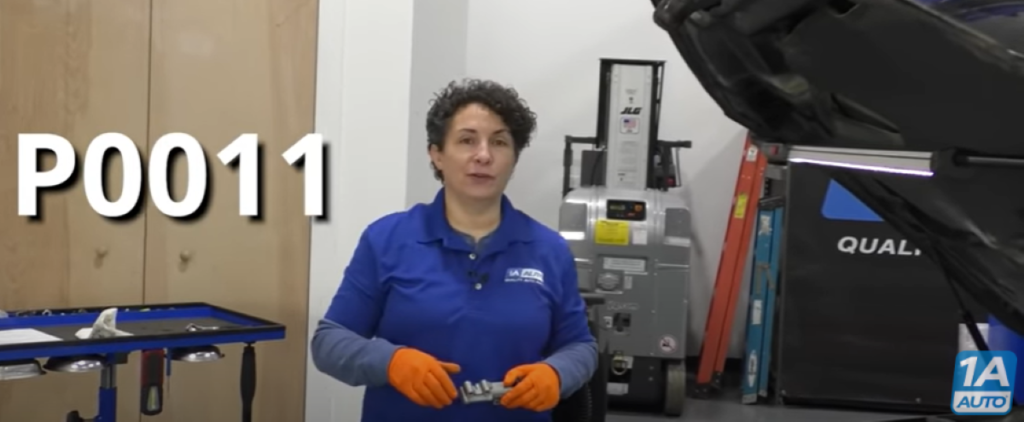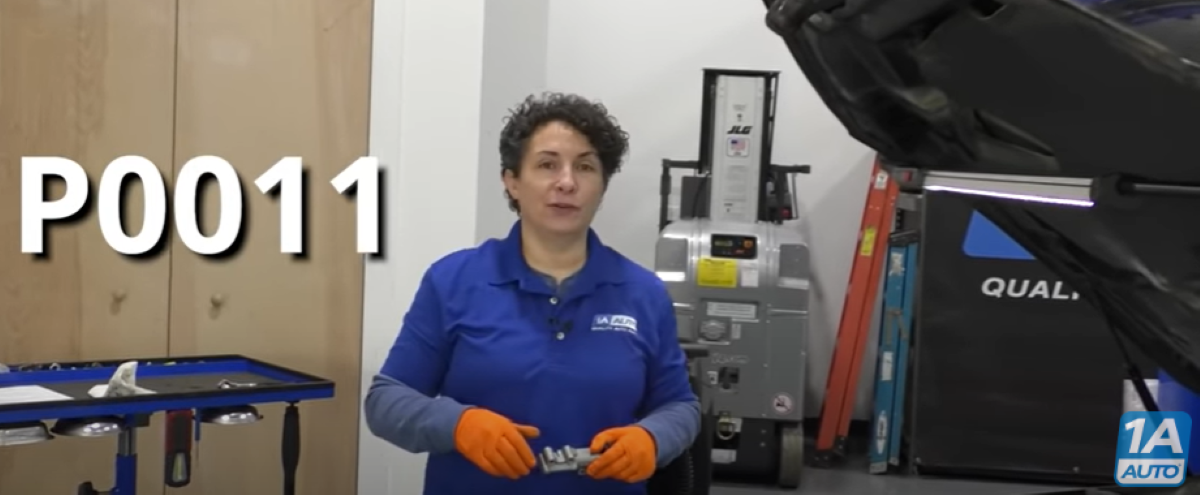If a check engine light for a P0011 code appears, there could be a problem like an oil leak or a part like the VVT solenoids. Find out what code P0011 means and how to diagnose and fix it with these tips.
What Does Code P0011 Indicate?

Code P0011 refers to the variable valve timing or variable camshaft timing, specifically the “A” camshaft in bank one. This means there’s a problem with the camshaft timing, which can cause a rough running engine.
What to Do If a Check Engine Light Appears for Code P0011
In this article and video, we have a rough running engine and a check engine light for code P0011. We also have codes P0081, P0303, P0507, and an engine misfiring and burning oil with a low oil level and oil consumption issues. We review what to do if this happens, and how these other issues are related by checking the variable valve timing (VVT) solenoids and finding out where oil is going and what problems it could be causing.
Diagnose the Engine for Code P0011
You’ll want to check a few areas of your vehicle to diagnose what’s causing the P0011 code to appear and how to fix and prevent it.
Steps to diagnose code P0011
- Find the VVT Solenoid’s Location
Before lifting the car up on a jack and jack stands and checking for oil leaks, find the VVT solenoid’s location. You may have to remove parts like the intake manifold to access them.
- Check the Oil Level
If there’s not enough oil, not be enough oil pressure will be at the VVT solenoids. Check the oil level and condition. You’ll need a proper oil level to test the VVT solenoids.
More on how to check the oil - Check for Oil Leaks
Check the oil pan for leaks or any signs of oil dripping. You may find a small one at the drain plug gasket, but this is common and is not considered a leak.
Check the timing belt area.
If you find a low oil level and no signs of leaking, the engine could be burning oil.
Check the exhaust pipe for any cracks or heavy amounts of soot. The end of the tailpipe, for example, should not have a lot of soot. See if you can find any trails of soot, which is not a good sign. In our example, the soot had weight to it, meaning oil could be burning inside. If the engine is burning oil, it may not leave enough smoke out of the exhaust to see with a naked eye, but this is a sign oil is leaving the valves.
- Run the Engine Until It’s Warm
Run the engine until it’s hot. See if the engine idle drops. You’ll need a warm engine to test the VVT solenoids. It’s not a good sign if the engine idle isn’t dropping. As mentioned before, we also have a misfire, codes related to the variable valve timing, low oil level, oil consumption issues, and the engine is burning oil.
- Test the Function of the VVT Solenoids
2 Methods to Test the VVT Solenoids
We are following a test from the manufacturer for both VVT solenoids. If you can’t access a printout of the schematic, we also review how to bench-test these parts.
Test 1: Back-Probe and Ground Out the VVT Solenoids
Test to see if the solenoid is frozen. They tend to freeze, and many freeze from lack of oil changes.
You can ground out the power source for both solenoids at the front and back bank.
While we don’t recommend back-probing as a go-to method, which is probing from the connector to measure a live electrical circuit, we’ll be using it for these solenoids.
The VVT solenoid has an electrical connector with two wires, and the schematic indicates one is for power. You can also test this wire with a multimeter and check for voltage. This will allow you to confirm you have voltage going to both VVT solenoids and a reference point with the key on.
Back-probe the VVT solenoid electrical connectors and ground out to the body of the vehicle. Then start the car and run it. You should notice an instant drop in RPMs if everything is working fine. With the engine running, tap the ground around 20 times, and watch and see if you can hear the timing advance and de-advance. If you tap the ground and the timing advances, the cam sprockets and timing chain are working fine. If you tap the ground and the idle doesn’t fluctuate with a timing advance, it means the camshafts are not working along with a VVT solenoid that’s probably frozen.
In our case the idle fluctuates when we tap the ground, and we know the cams activate when we ground out both VVT solenoids at the same time because we can hear them snapping back and forth. To fix the problem on the vehicle in our example, we’ll do a proper oil change, replace the VVT solenoids, clear the code, and test drive the car.
Test 2: Bench-Test the VVT Solenoids
You can also remove the VVT solenoids and test them on a bench. At 14:50 in the video, we demonstrate how a new and old VVT solenoid sounds and works. A defective VVT solenoid will be slow to operate or won’t operate at all.
You can test the VVT solenoid by removing it and putting power and ground to the solenoid with a power probe. If you don’t have a power probe, you can also use a battery pack or the battery. You can attach an alligator clip to the positive and negative on the battery, but make sure they don’t touch or come in contact with each other.
To remove the solenoid, disconnect the electrical connector from the solenoid. Then remove the three mounting screws, and make sure they’re all the same length so you don’t have to be specific and can just lift the solenoid up and out.
Lift the carbon gasket up and out and make sure debris behind it doesn’t fall down into the ports. Then clean the mating surface with a razor blade.
With the solenoid removed and on a bench, turn the power probe on. Clip an alligator clip to the electrical connector and insert the probe. You can see it ground out in the video around 15:38 because the circuit isn’t broken. Then add power. If the solenoid isn’t working, it’ll make a slow, small click from the plunger and will only move partially up and down. It won’t sound like it’s working fully.

- Replace the Defective VVT Solenoid
You may have to remove more parts like the upper intake manifold to access the solenoids.
Before installing the solenoid, clean the mating surface with brake parts cleaner and a cloth rag. This will remove carbon residue left behind and make the surface as smooth as possible. Install a new gasket and tighten the solenoid by hand to prevent damage to the gasket. Then torque the bolts to manufacturer’s specifications, and reconnect the electrical connector. - Change the Oil
Do a proper oil change by draining the old oil, replacing the oil filter, adding new oil and checking the oil level.
More on how to change the oil - Clear the Codes and Test Drive the Car
Clear the codes. Then test drive the car and make sure the code or symptoms don’t return.
What Can Cause Code P0011 to Appear?
Problems with VVT Solenoids, Camshaft, or the Timing Chain
If a check engine light for code P0011 appears, the VVT solenoid may be frozen or damaged. There could also be an issue with the camshafts or timing chain where they’re not working properly.
Oil Leaking or Burning
A lack of oil pressure can cause this code to appear. If there is low oil, like from having oil leaking or burning, the VVT solenoid doesn’t send a message to the computer to advance the timing, and this can lead to a check engine light, and a ticking sound or rough running engine. Also, sometimes the timing chain doesn’t get pressure to it, and this is an area you’ll want to inspect as well. You may also have a problem with engine oil consumption,
What Causes the VVT Solenoid to Fail?
Not Changing the Oil at Recommended Intervals
Usually not using the right oil or not changing the oil at the manufacturer’s recommended intervals causes the screen on the solenoid to clog, and this will cause problems with the plunger’s ability to move up and down. It may not fully move up and down or it may freeze entirely.
Using the Wrong Oil
The VVT solenoid has a screen and plunger. Bad oil can clog the screen, the plunger isn’t capable of fully functioning, and a check engine light appears related to a problem with the timing. You may also find when you press the gas, the engine needs the advanced timing for quick pick up, and it’s slow to respond because the VVT solenoid is not working correctly and the computer isn’t getting the right signal.
More on how a solenoid in a car works
How to Prevent Code P0011 from Appearing
Change the Oil Correctly
To prevent problems with the timing and from code P0011 from appearing, keep up with oil changes. Use the right oil and follow the recommended intervals from your vehicle’s manufacturer.
Learn How to Work on Your Car
Find out how to do many different kinds of repairs on your car with tips from our expert mechanics. With the instructions in our how-to videos, you can learn how to diagnose parts on many different models or in general.
Shop Quality Auto Parts


